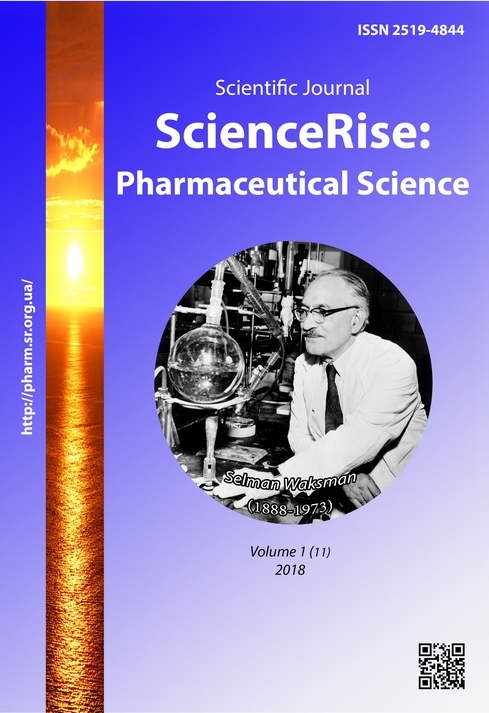Дослідження токсикологічного профілю нового гелю, що містить екстракт кори дуба та екстракт алое
DOI:
https://doi.org/10.15587/2519-4852.2018.123978Ключові слова:
гостра токсичність, екстракт кори дуба, екстракт алое, гель, токсичність, екстрактАнотація
На сьогоднішній день хвороби пародонту значно поширені, діагностуються більш ніж у 75 % населення всього світу, при цьому уражують всі вікові групи. Перспективними лікарськими препаратами слід вважати засоби на основі лікарської рослинної сировини, які поряд із вираженою терапевтичною дією мають мінімум негативних реакцій.
Метою роботи було дослідження гострої токсичності нового гелю, що містить екстракт кори дуба та екстракт алое.
Методи. Дослідження гострої токсичності проводили відповідно до методичних рекомендацій на білих нелінійних щурах масою 180–220 г, у декілька етапів: дослідження гострої токсичності компонентів нового гелю, дослідження гострої токсичності нового гелю за умов внутришньошлункового ведення, внутрішньоочеревинного та при нашкірному нанесенні.
Результати. Встановлено, що за умов внутришньошлункового введення екстракту кори дуба та екстракту алое неможливо встановити ЛД50, тому що введення максимальної дози 15100 мг/кг не викликало летальності щурів. У зв’язку з цим у подальших дослідженнях, з метою підтвердження цього твердження була досліджена гостра токсичність екстрактів лише у дозі 15100 мг/кг. При внутришньоочеревинному введенні досліджувані ЛД50 екстракту кори дубу становить 2580 (1930–3220) мг/кг, екстракту алое 2180 (1460–2900) мг/кг. На подальших етапах дослідження не було зареєстровано видимих ознак токсичного впливу нового гелю на функціональний стан тварин під час спостереження протягом 14 діб при введені у максимально рекомендованих дозах: внутрішньошлуноково 15100 мг/кг та нашкірно 22600 мг/кг.
Висновки. Комплекс проведених досліджень дозволив встановити, що новий гель не чинить токсичного впливу на органи та системи дослідних тварин та не має летальної дії. Екстракт кори дуба та екстракт алое за умов внутрішньошлункового введення відносяться до VІ класу токсичності «Відносно нешкідливі речовини». При внутришньоочеревинному введенні досліджувані екстракти відносяться до V класу токсичності «Практично нетоксичні речовини». За показником вивчення гострої токсичності новий гель за умов внутришньошлункового та нашкірного нанесення відносяться до VІ класу токсичності «Відносно нешкідливі речовини»
Посилання
- Borisenko, A. V. (2013). Influence of periodontal diseases on the general state of the organism. Health of the Society, 1, 32–37.
- Savelyeva, N. M. (2017). Features of the clinic, diagnostics, treatment and prophylaxis of generalized periodontitis in patients with parasitic invasion. Odessa, 398.
- Panezai, J., Ghaffar, A., Altamash, M., Sundqvist, K.-G., Engstrom, P.-E., Larsson, A. (2017). Correlation of serum cytokines, chemokines, growth factors and enzymes with periodontal disease parameters. PLOS ONE, 12 (11), 188–194. doi: 10.1371/journal.pone.0188945
- Wang, Y., Andrukhov, O., Rausch-Fan, X. (2017). Oxidative Stress and Antioxidant System in Periodontitis. Frontiers in Physiology, 8. doi: 10.3389/fphys.2017.00910
- Stanko, P., Izakovicova Holla, L. (2014). Bidirectional association between diabetes mellitus and inflammatory periodontal disease. A review. Biomed Pap Med Fac Univ Palacky Olomouc Czech Repub, 158 (1), 35–38. doi: 10.5507/bp.2014.005
- Aoyama, N., Suzuki, J.-I., Kobayashi, N., Hanatani, T., Ashigaki, N., Yoshida, A. et al. (2017). Associations among tooth loss, systemic inflammation and antibody titers to periodontal pathogens in Japanese patients with cardiovascular disease. Journal of Periodontal Research, 53 (1), 117–122. doi: 10.1111/jre.12494
- Hamilton, J. A., Hasturk, H., Kantarci, A., Serhan, C. N., Van Dyke, T. (2017). Atherosclerosis, Periodontal Disease, and Treatment with Resolvins. Current Atherosclerosis Reports, 19 (12), 57–65. doi: 10.1007/s11883-017-0696-4
- Pritchard, A. B., Crean, S., Olsen, I., Singhrao, S. K. (2017). Periodontitis, Microbiomes and their Role in Alzheimer’s Disease. Frontiers in Aging Neuroscience, 9, 336–338. doi: 10.3389/fnagi.2017.00336
- Ramesh, A., Varghese, S., Doraiswamy, J., Malaiappan, S. (2016). Herbs as an antioxidant arsenal for periodontal diseases. Journal of Intercultural Ethnopharmacology, 5 (1), 92–96. doi: 10.5455/jice.20160122065556
- Tsubanova, N. A., Hohlenkova, N. V., Zhurenko, D. S., Matthew, І. І. (2016). Pat. No. 109792 UA. Pharmaceutical composition in the form of a dental gel with parodontoprotective action. MPK A61K 36/49, A61K 36/889, A61K 129/00, A61P 1/02. No. U 2016 01693; declareted: 23.02.2016; published: 12.09.2016, Bul. No. 17, 5.
- Zhurenko, D. S., Sagittarius, O. P., Hochlenkova, N. V., Matthew, I. I. (2016). Study of antimicrobial activity of «Аloedental» gel for treatment of periodontal diseases. Medicines of Ukraine plus, 3 (28), 34–36.
- Tsubanova, N. A., Hohlenkova, N. V., Zhurenko, D. S., Matthew, I. I. (2016). Research of efficiency new gel containing an extract of oak bark and extract of aloe vera under condition protamine periodontitis. Ukrainian biopharmaceutical journal, 2 (43), 27–31.
- Yarborough, M., Dirnagl, U. (2017). Preclinical research: Meet patients to sharpen up research. Nature, 551 (7680), 300–310. doi: 10.1038/d41586-017-06024-2
- Boncler, M., Golanski, J., Lukasiak, M., Redzynia, M., Dastych, J., Watala, C. (2017). A new approach for the assessment of the toxicity of polyphenol-rich compounds with the use of high content screening analysis. PLOS ONE, 12 (6), 180–188. doi: 10.1371/journal.pone.0180022
- Stefanova, O. V. (Ed.) (2001). Preclinical research of medicinal products. Kyiv: Avicenna, 528.
- Reznikov, O. G. (2003). General ethical principles of experiments on animals. Endocrinology, 8 (1), 142–145.
- Sidorov, K. K. (1973). On the classification of toxicity of poisons in parenteral methods of administration. Toxicology of new industrial chemicals. Moscow, 13, 47–57.
##submission.downloads##
Опубліковано
Як цитувати
Номер
Розділ
Ліцензія
Авторське право (c) 2018 Natalya Tsubanova, Dmytro Zhurenko, Tatiana Sakharova

Ця робота ліцензується відповідно до Creative Commons Attribution 4.0 International License.
Наше видання використовує положення про авторські права Creative Commons CC BY для журналів відкритого доступу.









